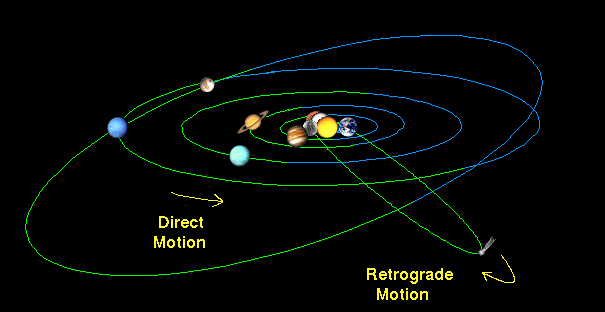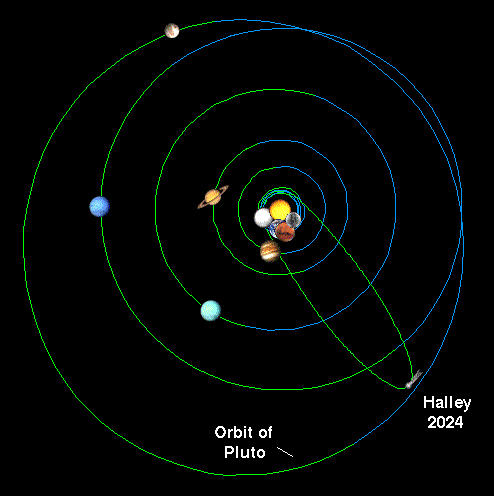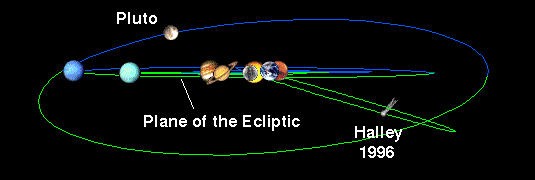 Comet Halley from Mount Wilson |
The best known comet of all is Halley, which has returned with a 74-79 year period since 240 B.C. The following image (Ref) shows a famous view of the full tail of Halley recorded from the Mount Wilson Observatory.
 Comet Halley from Mount Wilson |
 The English astronomer
Edmund Halley
was a good friend of Isaac Newton. In 1705 he used Newton's new theory of
gravitation to determine the orbits of comets from their recorded positions in
the sky as a function of time. He found that the bright comets of 1531, 1607,
and 1682 had almost the same orbits, and when he accounted for the
gravitational perturbation on the cometary
orbits from Jupiter and Saturn, he concluded
that these were different appearances of the same comet. He
then used his gravitational calculations to predict
the return of this comet in 1758.
The English astronomer
Edmund Halley
was a good friend of Isaac Newton. In 1705 he used Newton's new theory of
gravitation to determine the orbits of comets from their recorded positions in
the sky as a function of time. He found that the bright comets of 1531, 1607,
and 1682 had almost the same orbits, and when he accounted for the
gravitational perturbation on the cometary
orbits from Jupiter and Saturn, he concluded
that these were different appearances of the same comet. He
then used his gravitational calculations to predict
the return of this comet in 1758.
A Posthumous Christmas PresentHalley did not live to see his prediction tested because he died in 1742. But on Christmas night, 1758, the comet destined everafter to bear Halley's name reappeared in a spectacular vindication of his bold conjecture and of Newton's gravitational theory. Tracing back in the historical records for recordings of bright comets and their positions in the sky, it was concluded that Halley had been observed periodically as far back as 240 B.C. The most recent return was in 1986, and the predicted next appearance of Halley in the inner Solar System will be in 2061. |
|
 Halley's Comet in 2024 |
Blue is above the plane of the ecliptic and green is below. Almost the entire Halley orbit is below the plane of the ecliptic. Further, Halley revolves around its orbit in retrograde motion (the opposite sense from planet revolution). In the preceding view the planets revolve counter-clockwise and Halley revolves clockwise. The following image shows the same thing, but from a top view.
 Halley's Comet in 2024---Top View |
Notice that Halley's orbit extends essentially to the distance of Pluto, but when Halley is at its greatest distance from the Sun (aphelion) it is below the plane of the ecliptic (green color) while that portion of Pluto's orbit is above the plane of the ecliptic (blue color). The following image illustrates this more clearly. It is a view of the orbit of Halley and its 1996 position from the vantage of the ecliptic plane:
 Solar System View from the Ecliptic Plane |
This view illustrates clearly four important features of our Solar System: